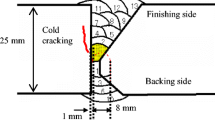The brittle fracture of the weld joint at low stresses is controlled by high-strength steel characteristics and welding defects. Based on fracture mechanics, the fracture behavior of the weld–base metal interface of a high-strength steel weld joint was studied to reveal the critical locations of the latter. From tensile fracture experiments of 45 steel welded specimens, the load–displacement curve and the fracture modes of weld joints were obtained. The results indicate that the critical loads and fracture modes are influenced by the crack slope angle. The maximum load of interface fracture in weld joints is less than that of the failure in the base metal mainly related to the existence of initial defects in the weld joint. The fracture surface morphology was also detected. It is considered that the fracture surface is influenced by different fracture locations and different microstructure of the weld and base metals. In addition, the critical stress intensity factors of a weld interface crack were calculated based on the critical load and the finite element linear extrapolation method. The linear fracture assessment criteria were proposed, which will be applicable to safety evaluation for the weld joints of high-strength steel structures.








Similar content being viewed by others
References
J. Wang, J. D. Zhao, and Z. Y. Hu, “Review and thinking on development of building industrialization in China,” China Civil Eng. J., 49, No. 5, 1–8 (2016).
D. Arsiã, M. Djordjeviã, J. Zivkoviã, et al., “Experimental-numerical study of tensile strength of the high-strength steel S690QL at elevated temperatures,” Strength Mater., 48, No. 5, 687–695 (2016).
P. Moþe, D. Beg, and J. Lopatic, “Net cross-section design resistance and local ductility of elements made of high-strength steel,” J. Constr. Steel Res., 63, No. 11, 1431–1441 (2007).
M. K. Samal, M. Seidenfuss, E. Roos, and K. Balani, “Investigation of failure behavior of ferritic–austenitic type of dissimilar steel weld joints,” Eng. Fail. Anal., 18, No. 3, 999–1008 (2011).
N. Guo, Z. Yang, M. Wang, et al., “Microstructure and mechanical properties of an underwater wet welded dissimilar ferritic/austenitic steel joint,” Strength Mater., 47, No. 1, 12–18 (2015).
S. V. Kobel’skyi, S. M. Ban’ko, and V. V. Kharchenko, “Determination of stress intensity factors in the weld joint between the header and shell of PGV-1000M steam generator with a defect in the form of a cavity with a crack,” Strength Mater., 47, No. 2, 297–301 (2015).
H. W. Lee, W. H. Choe, J. U. Park, et al., “Weld metal hydrogen assisted cracking in 50 mm TMCP steel plate with SAW process,” Sci. Technol. Weld. Joi., 11, No. 3, 243–249 (2013).
A. Ya. Krasovskii, I. V. Orynyak, E. E. Gopkalo, “Fractography of in-service fracture of the metal in weld joint No. 111 of the steam generator of a WWER-1000 power unit,” Strength Mater., 47, No. 5, 670–678 (2015).
P. J. Budden and I. Curbishley, “Assessment of creep crack growth in dissimilar metal welds,” Nucl. Eng. Des., 197, Nos. 1–2, 13–23 (2000).
R. Kandrotaitë-Janutienë and A. Baltuðnikas, “Investigation of plastic behavior of alloyed steel deformed during martensitic transformation,” Strength Mater., 48, No. 5, 696–703 (2016).
M. K. Samal, K. Balani, M. Seidenfuss, and E. Roos, “An experimental and numerical investigation of fracture resistance behaviour of a dissimilar metal weld joint,” P. I. Mech. Eng. C - J. Mec., 223, No. 7, 1507–1523 (2009).
C. Jang, J. Lee, J. S. Kim, et al., “Mechanical property variation within Inconel 82/182 dissimilar metal weld between low alloy steel and 316 stainless steel,” Int. J. Pres. Ves. Pip., 85, No. 9, 635–646 (2008).
A. Laukkanen, P. Nevasmaa, U. Ehrnstén, and R. Rintamaa, “Characteristics relevant to ductile failure of bimetallic welds and evaluation of transferability of fracture properties,” Nucl. Eng. Des., 237, No. 1, 1–15 (2007).
H. T. Wang, G. Z. Wang, F. Z. Xuan, and S. T. Tu, “An experimental investigation of local fracture resistance and crack growth paths in a dissimilar metal weld joint,” Mater. Design, 44, 179–189 (2013).
M. T. Kirk, K. C. Koppenhoefer, and C. F. Shih, “Effect of constraint on specimen dimensions needed to obtain structurally relevant toughness measures,” in: E. M. Hackett, K.-H. Schwalbe, and R. H. Dodds (Eds.), Constraint Effects in Fracture, STP 1171, ASTM International, West Conshohocken, PA (1993).
GB 50661-2011. Code for Welding of Steel Structures, Chinese Standard, Implemented on August 1, 2012.
S. Maiti, Fracture Mechanics: Fundamentals and Applications, Cambridge University Press (2015).
G. P. Liang, Finite Element Language and Its Application [in Chinese], Science Press, Beijing (2013).
Acknowledgments
The work is supported by the Fundamental Research Funds for the Central Universities (126545010), the supported by Southeast University, Key Laboratory of Concrete and Prestressed Concrete Structures of Ministry of Education (CPCSME2015-03).
Author information
Authors and Affiliations
Corresponding author
Additional information
Translated from Problemy Prochnosti, No. 1, pp. 17 – 26, January – February, 2018.
Rights and permissions
About this article
Cite this article
Zhong, Z.P., Liu, H. & Ma, J.J. Fracture Assessment of the Weld–Base Metal Interface of High-Strength Steel Weld Joint. Strength Mater 50, 11–19 (2018). https://doi.org/10.1007/s11223-018-9937-1
Received:
Published:
Issue Date:
DOI: https://doi.org/10.1007/s11223-018-9937-1




